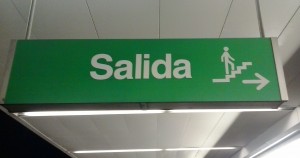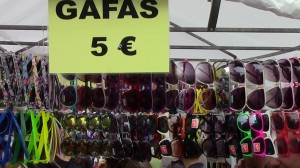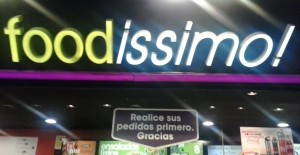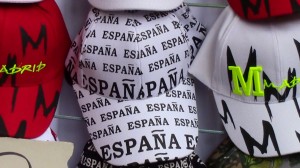The language learner in a new place is full of doubts, insecurities, and fears – big breaths in through the mouth and out through the nose are essential. As is a big L sign hung around the neck to indicate that word carnage is on the way. Converse with caution y más despacio por favor.
“Do you want to go faster?” I remember the Holiday Bounce carney at the CNE* would yell to us 20 or so screaming kids, all holding on to our seats for dear life. Aqui, en la feria la pregunta is similar: ¿Te gusta ir rápido o despacio? Para los niños la respuesta es: ¡rápido! For me, it’s despacio por favor. For now, at least.
You see, I still talk like an 8 year old, and prefer my conversation slow, repeated, and light on Marx and Nietzsche (or Santayana and José Ortega y Gasset), although my ability does seem to improve with cerveza y vino tinto y sidra en Asturias.** On a recent trip to Madrid, Belén and I witnessed a conversation on the Metro*** between a mother and her young boy which was exactly my speed. The mother was telling him what they would be doing, and what each of the next stops would be, to which he would say, “¿Y después?” Over and over and over. Exactly what I needed. Simple, slow, repetitive. Aspergers Berlitz.
I was so into their simple rhythm that I wanted to follow them out and tag along, answering with the boy as his mother gave the next instruction: “Vamos al Prado.” “¿Y después?” Vamos al Thyssen.” “Y después?” “Vamos al Reina Sofía.” “¿Y después?” “Vamos al Rastro.” “¿Y después?” I could outlast him any day.
Of course, it’s tough for the language learner in any new place. I go back to the same stores again and again so I don’t have to explain how stupid I am again (they know from the first time). I order the same meals, the ones I understood before because it’s too big a gamble to try sesos de cordero. I pay with notes, unable to understand the quick rendering of el camarero o la camarera, and then pray that I understand how much change is right. My face is full of worry lines; my wallet is full of coins.
Signs help. While mingling in the streets with scores of tourists and locals alike, everybody’s checking everyone else out. Me, I’m looking at the signs for a clue, an aide, anything to get to level pegging. Anything to get me where I am going without too much pride lost. Of course, it’s okay to check out the goods, as long as I can learn along the way (las gafas o los abanicos).
As for las costumbres, well, that’s a whole other language learner’s can of worms. So far, organized queues are easier since I can’t speak well enough to assert myself when some dolt cuts in front of me. And I am sorry for honking at the jubilado who was just waiting his turn to park the other day. In any language, one wants to know what is ahead. I may not understand all the words, but I am starting to get the poetry of signs and signals of sympathetic looks and sonrisas.
Such is the life of a newbie extranjero (say that fast three times), which I know will get easier, although there is something edifying about jumping in at the deep end to drink a beer or a wine or a cider in a foreign land. To be sure, yo quiero beber rápido pero hablar despacio. Whether cerveza, vino tinto, o sidra. Tomorrow, I shall try harder, listen better, and think more. ¿Y después?









